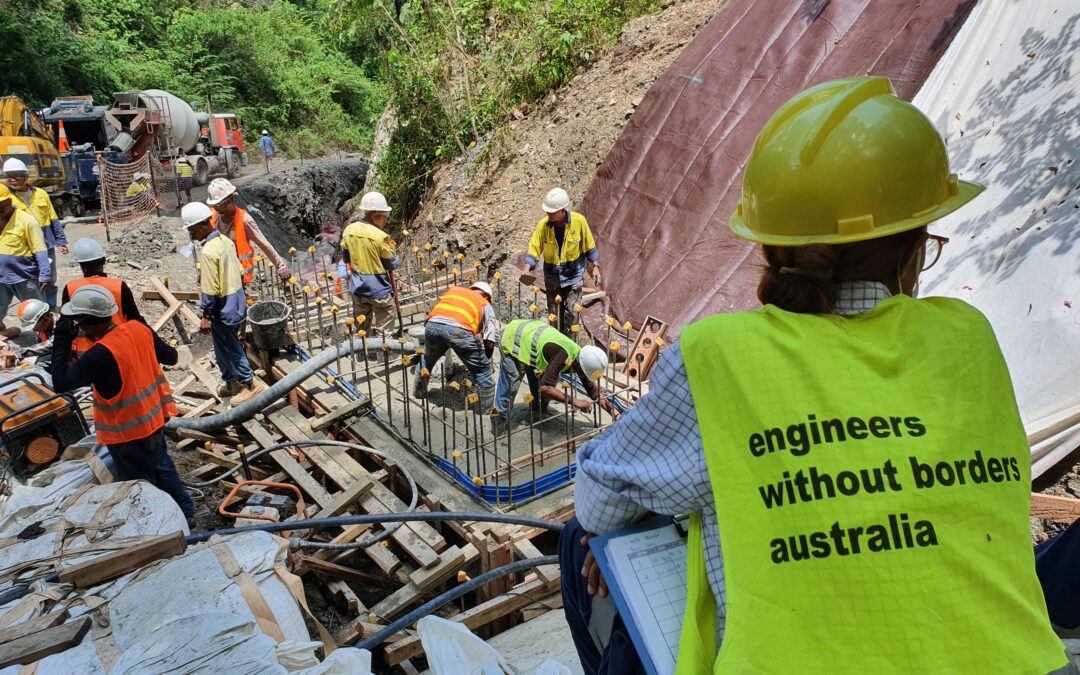The Dili Water System Emergency Repair Program (DWSERP) addressed the catastrophic flood damage to Dili’s water transmission systems wreaked by heavy rains in April 2021. The program, funded by the Australian Government via the Department of Foreign Affairs and Trade, commenced in June 2021 and concluded in June 2023. EWB Australia, along with its program partners, played a key role in providing technical support, concept design, advice and delivery of multidisciplinary engineering to repair and stabilise major sections of Dili’s water system. The project was a wonderful opportunity for EWB to display its ability to engage in emergency infrastructure recovery projects. With the project now complete, the project team shared some of their reflections.
When the devastating floods first hit Dili in April 2021, over 11,000 people were displaced from their homes and 45% of Dili’s population were without ongoing or reliable access to clean water. While the need for safe and clean water was immediately addressed through the provision of clean water delivery and temporary filtration systems, it was the significant impacts on infrastructure to key sections of Dili’s water system that required more significant reparation works. EWB was part of a partnership which included Be’e Timor-Leste E.P. (Dili’s newly established water utility), PARTISIPA (the Australian Government’s program supporting the government of Timor Leste in subnational infrastructure and decentralisation) and global engineering firm Cardno/DT Global. The project was led by the Timor-Leste Government, funded by the Australian Government and construction was completed by local contactor RMS.
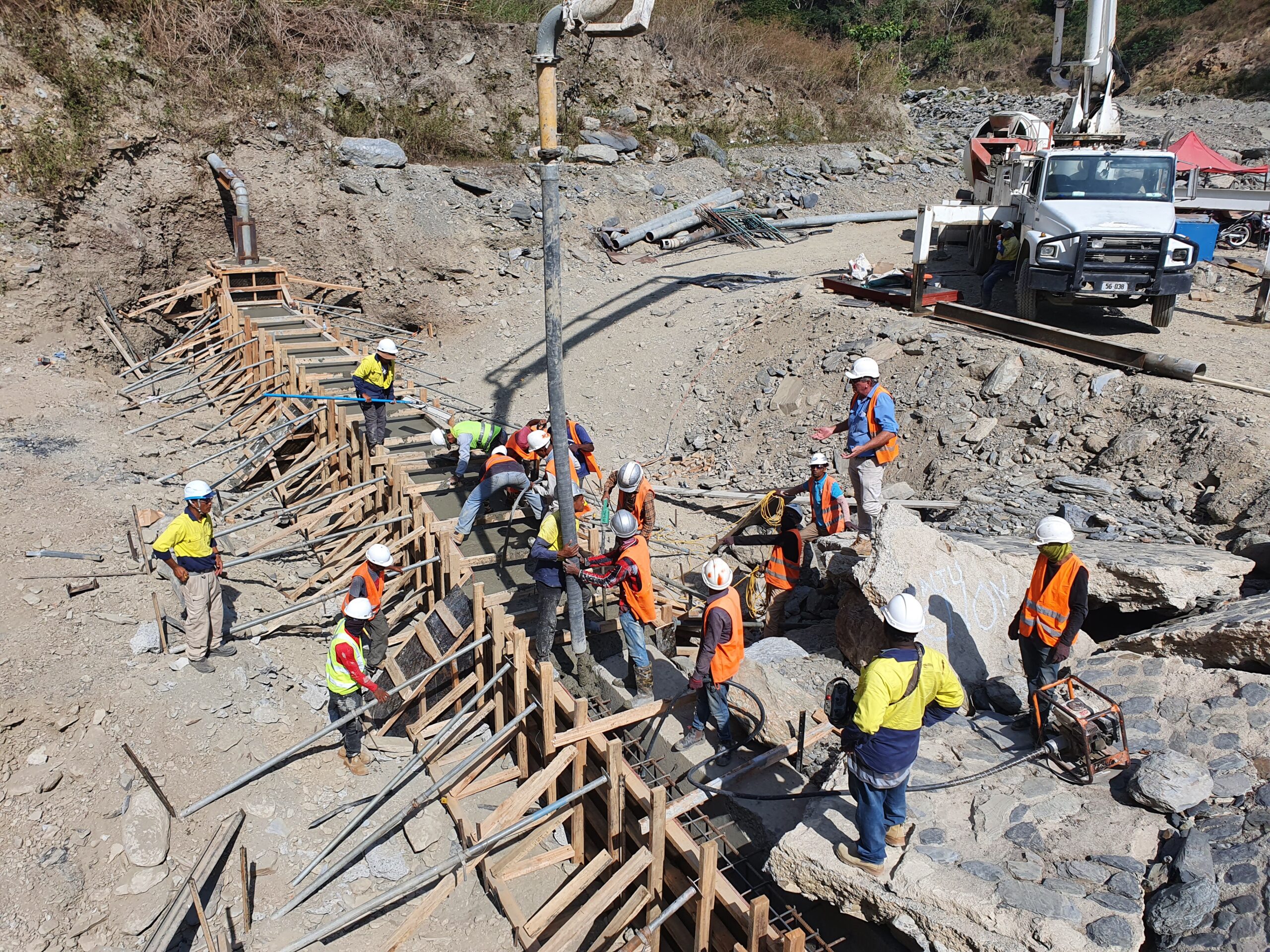
Local contractor, RMS, pouring concrete in a pipe encasing in Beemos. During the April 2021 floods, the river channel changed and piping was exposed. To enhance its durability and ensure long-term resilience, the pipe’s alignment was lowered and encased in fibre-reinforced concrete.
Although intended as an emergency response, in reality the project was a full situational analysis leading into infrastructure design and construction, in order to build back better. Two sites were the major focus of this project – one in Mutudare River (a steep and narrow river valley in the foothills adjacent to Dili) and the other in Beemos River (a much larger river with an expansive catchment area, a tributary of Dili’s main river, the Comoro). The Beemos River supplies the most significant source of water for Dili’s entire water system, providing up to 3.5 ML of water daily. With a large catchment area and very fast concentration time as a result of the steep surrounding terrain, the Beemos River saw flood waters up to 6 metres deep during the April 2021 event. The impact of flash flooding this severe was catastrophic to all infrastructure in its path, hence a new approach of burying HDPE pipeline out of harm’s way was adopted for the system repair. Mutudare River also saw extremely high-velocity flooding, which caused catastrophic damage to existing infrastructure.
Repairs to the Beemos system were made by DWSERP over 900 metres, using 300-mm-diameter HDPE and steel pipelines, as well as the construction of two major scour valve pits (one over 5 metres high), a new pipe bridge, two river crossings and an 80-metre-long concrete-encased gabion pipe protection structure. At Mutudare, 500 metres of 300 mm HDPE and 150 mm steel pipe was installed, all trenched into gravel and bedrock as deep as 3 metres in some places. Also at Mutudare, a new weir, intake tank and protection structure were constructed, as well as four river crossings, a scour valve and rehabilitation of a historic pipe bridge from the era of Portuguese colonisation. Overall, the project sought to benefit approximately 70,000 people who receive supply from these systems and, more broadly, the 221,000 people who reside in the capital of Dili.
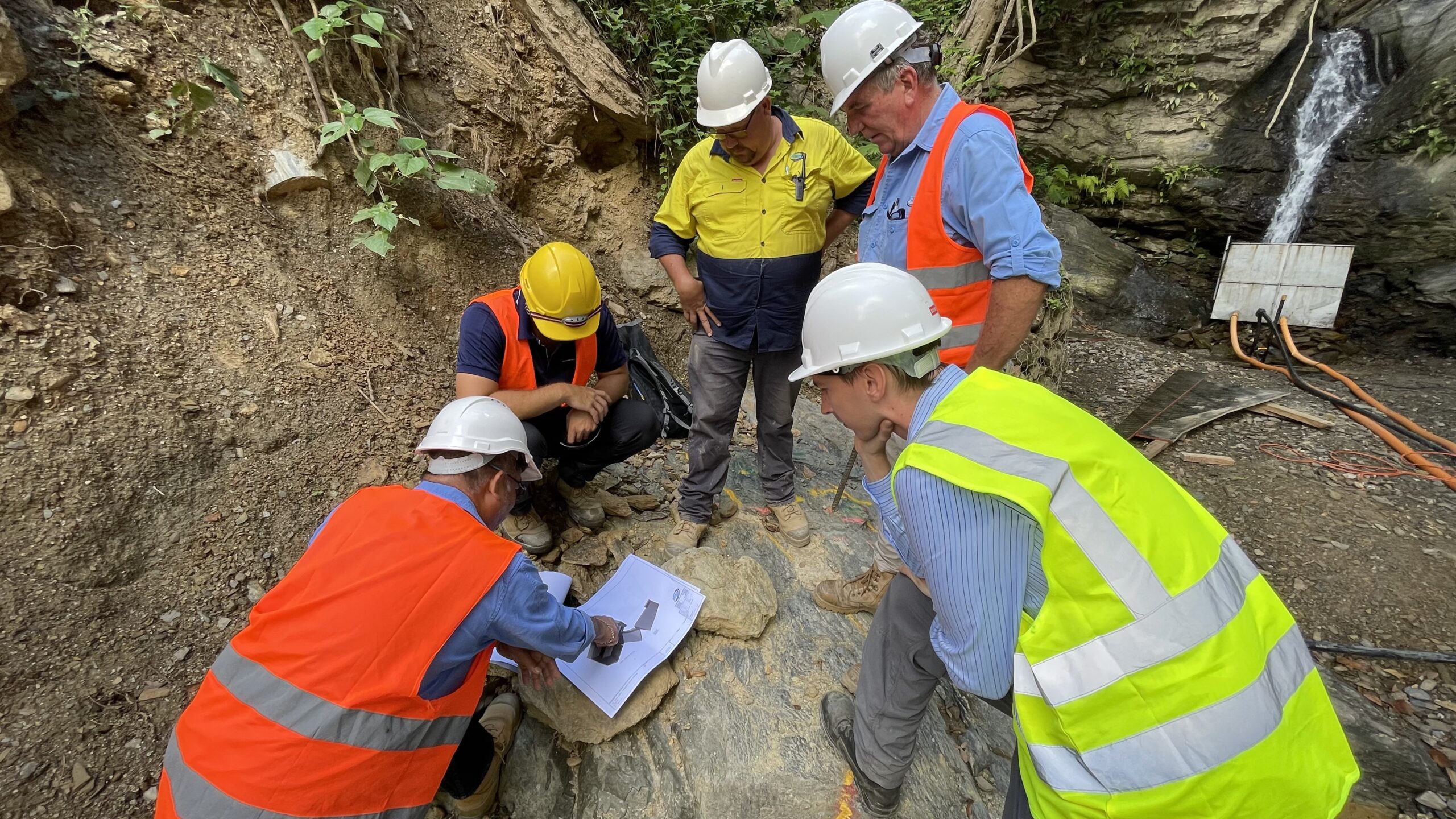
EWB, DT Global and RMS meeting on site to discuss the re-design of the intake weir and intake tank at Mutudare following heavy rain during construction, which destabilised the adjacent embankment. The re-design sped up construction, mitigated safety concerns for workers and reduced the amount of concrete required overall, therefore reducing the emissions footprint of the infrastructure.
The wet season
The intensity of the wet seasons in Timor-Leste played havoc with this project, particularly when pipeline construction was surrounded by steep embankments and in fast-flowing rivers. During the project, two of the three largest rainfall events of the year occurred in the midst of construction on the Mutudare site. This extreme weather destroyed newly constructed trenches and pipework, which increased the duration of the construction phase of the project. During these flood events, the water moves incredibly fast – in the 2021 floods, the torrent moved metres-long slabs of concrete (weighing as much as 5 tonnes) hundreds of metres downstream. Choices in design and materials needed to have long-term sustainability in mind. To address this, pipes were buried, which ensured future-fit infrastructure. Pipework was also encased in concrete where its alignment crossed under the bed from one river bank to the other, to protect it against such powerful flash flooding. In fact, concrete featured heavily throughout the construction due to its strength and durability, but the team was conscious of its contribution to the creation of carbon emissions. As such, it was used only when absolutely necessary.
Dangers and dilemmas
The project threw up multiple challenges. Construction necessitated the removal of vegetation and trees which changed the course of some of the smaller creeks and made them vulnerable to further erosion and sediment run-off. Revegetation as part of the project aimed to mitigate these issues. Active landslides were a safety issue, and one of the intake structures was strategically repositioned to counteract future landslides on that site. Unexploded ordnances, including mortars and a landmine dating back to World War II, were discovered on one of the sites and required removal by the local police.
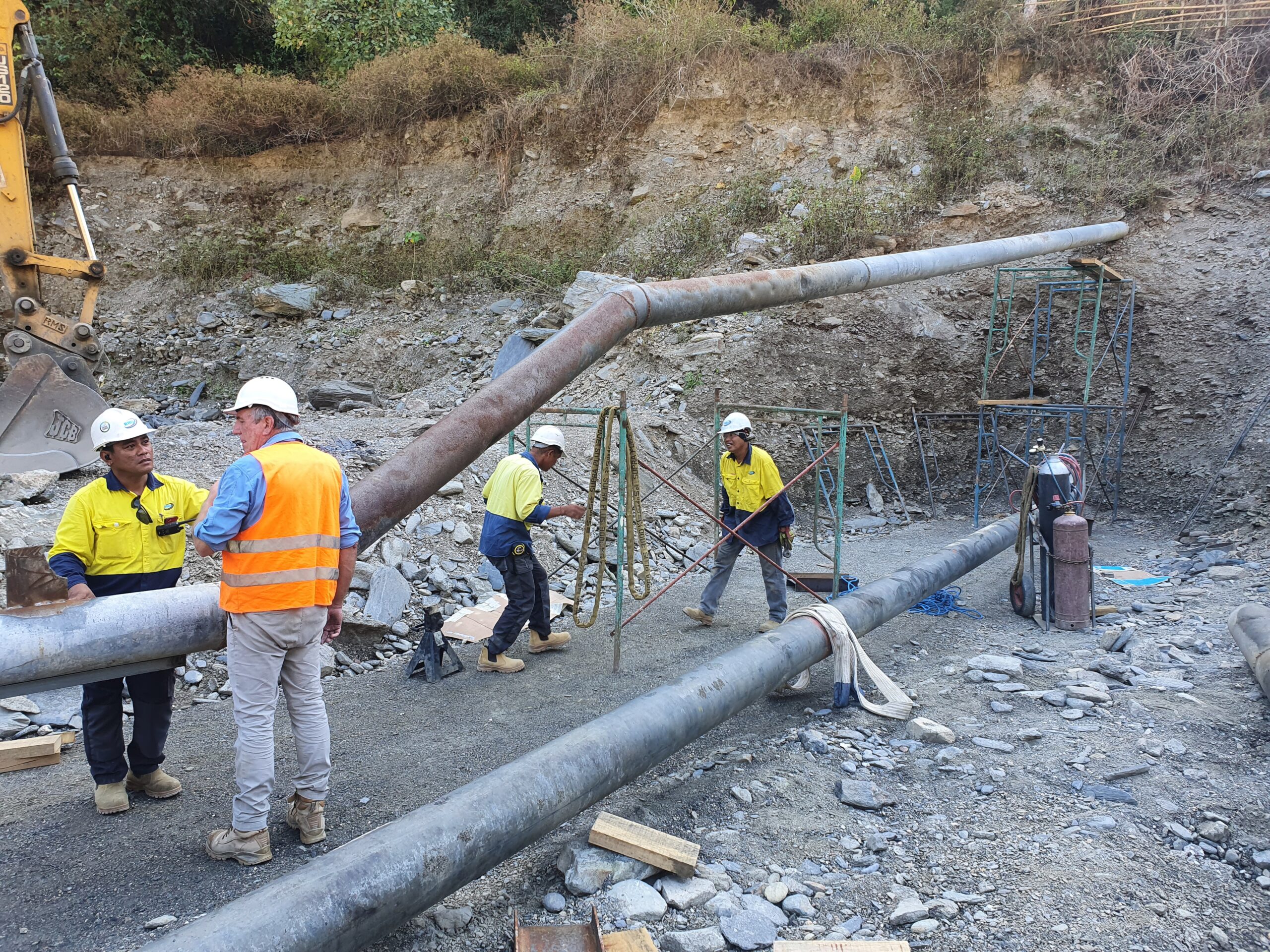
Contractor RMS preparing to lower the alignment of the pipe at crossing 2 at Beemos.
Limitations to accessing specific equipment and materials brought home the kinds of challenges that the Timorese people face every single day. The project required significantly longer lead times – sometimes months instead of weeks – to obtain materials that were unavailable in Timor-Leste. Sourcing materials from Indonesia was at times a faster solution than sourcing them from Australia, and procuring and manufacturing as much as possible within Timor-Leste ensured that some of the elements required were less expensive while providing local employment and skills development.
One locally available product was heavily used throughout the project – but inadvertently wiped out its supply to an unrelated sector. HDPE pipework expands under pressure, and a PVC foam wrapping allows enough space between the pipe and the concrete encasing to allow for that expansion without causing damage to the structure. A call out to source every PVC foam yoga mat in the country resulted in 200 mats being brought to site for the purpose. It also made for a pretty colourful section of pipework!
The health of the team was also challenged during the project, with several staff suffering from bouts of diarrhoea. This highlighted the effects of poor water quality that are endured by the Timorese people on an all-too-frequent basis.
Opportunities for local engineers
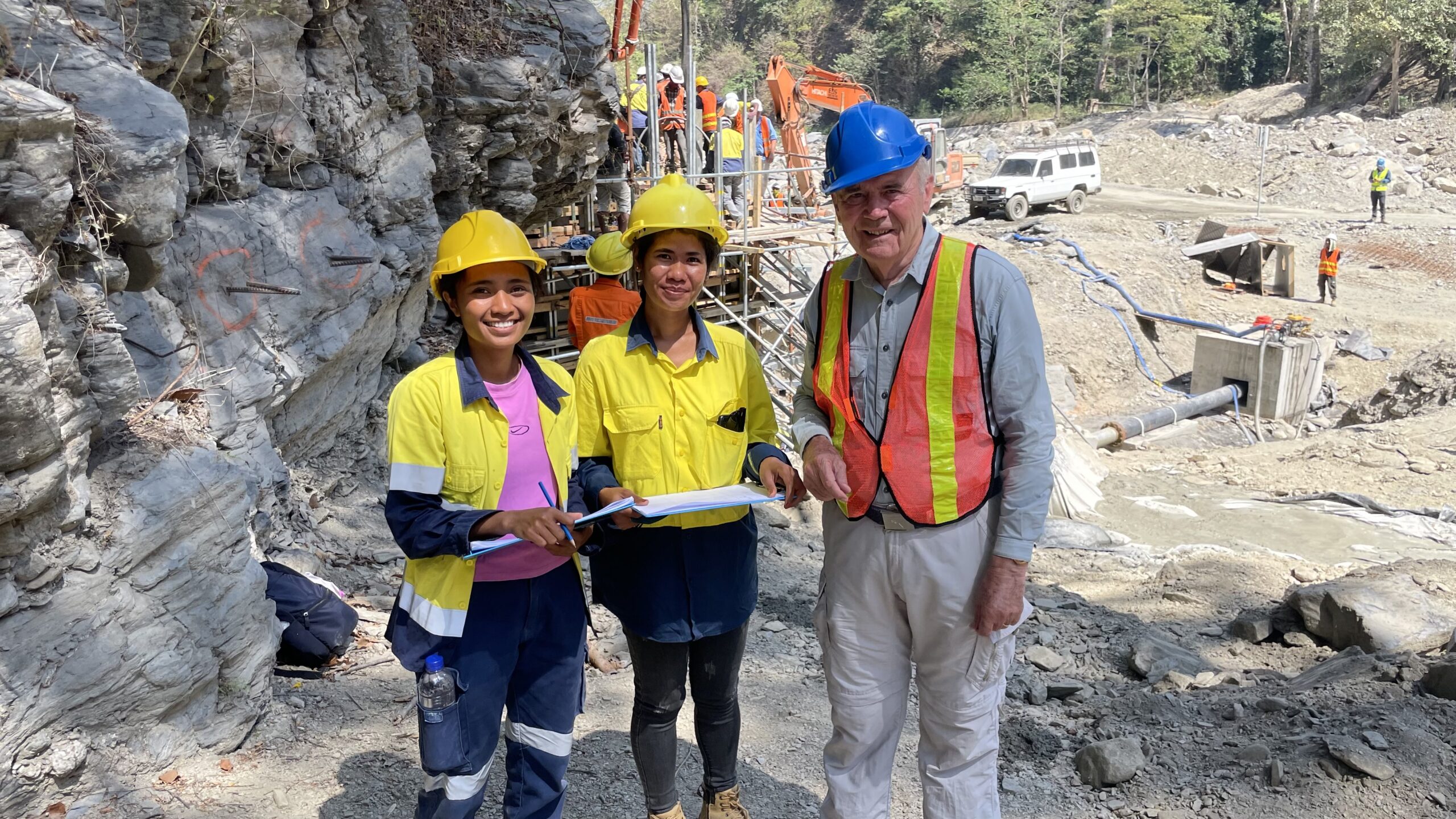
Feto Enginhera site engineers, Marta and Angelica, with EWB Project Director Richard, onsite at Beemos.
The project was one of the largest and most technically challenging jobs that many of the local project staff had ever worked on. This was particularly so for many of the Timorese female engineers who are still striving to gain meaningful experience in the sector within their own country. Many in the project team leaned into this unique opportunity to provide informal mentoring. For local female engineers like Angelica da Costa, the project has proved a career game-changer, with several now employed in roles with local programs.
Angelica is a Timorese civil engineer and a member of Feto Enginhera who worked as a site supervisor on the project for over 12 months. Angelica has volunteered her time with EWB since 2020 through Feto Enginhera. As a site supervisor, she monitored the project to ensure materials adhered to quality and design standards and assessed the quality of construction. For Angelica, this was a unique opportunity to build her technical skills, allowing her to gain confidence in identifying and assessing materials for their quality and environmental impact. She describes the project as a great experience which gave her the opportunity to work with a supportive team who collaborated to build skills in data collection.
Female engineers in Timor-Leste continue to face gender stereotypes and few opportunities to apply their practical skills. Empowering engineers like Angelica through participation in projects such as DWSERP is an important step in bridging the gender divide that exists in the industry.
More than clean water
Spending time working near the communities that reside along the rivers also afforded moments for the project team to support them where they could. In one instance, excess sand and concrete was offered to a local family, and the construction team helped them form a concrete slab for their new home. It is something this family ordinarily could never afford, and now they have built a sturdy house on top. Locals were also regularly employed as security on the worksites, to keep a watchful eye on the build mid-construction, and as labourers to construct the works and gain construction experience.
While there were many other positive outcomes as a result of the project, the primary focus was on the provision of clean, safe water – for the long term. Nearing the conclusion of the project, and enroute to the airport, one of our team drove past a young girl and boy who would have been around 12 years old. They were carrying two 10-litre jerry cans – one in each hand – filled with water from an unclean river. It is this scenario that this project seeks to stop.


